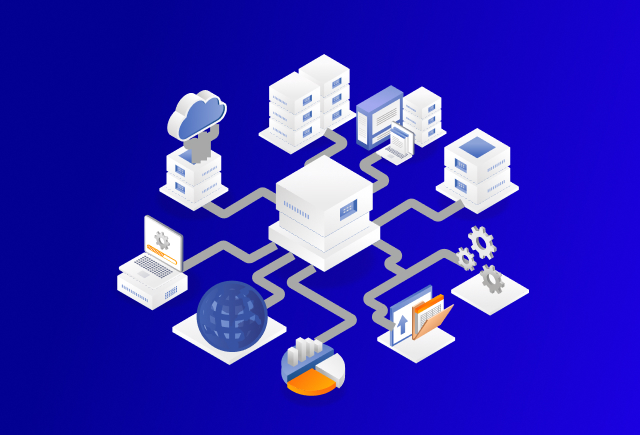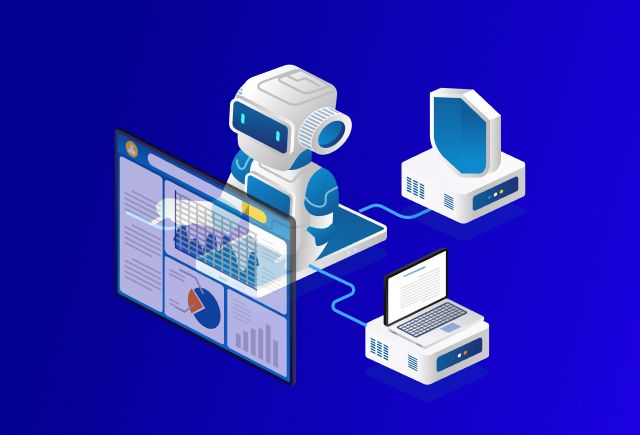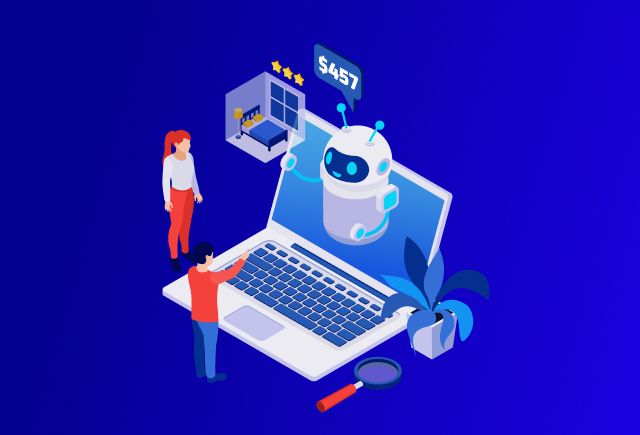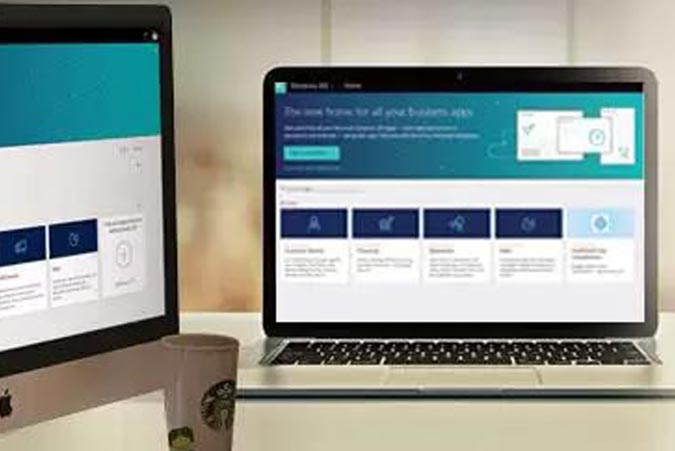10 Quintessential Elements to Look for in an RPA Support Package
Jun 07, 2022 Shireen Noushad
The journey to automation excellence starts with implementing RPA. As markets evolve and their demands change over time, businesses must rally their forces and ensure that their service offerings are up to the expected standards. To address the evolving demands, RPA support becomes a necessity and enlisting RPA Support Packages becomes crucial.
Before we get into what an RPA support package comprises of, let’s start by looking at the reasons why RPA bots need support.
Why Businesses Can’t Ignore RPA Support Services?
-
Unexpected RPA Behavior Due to Downtime
RPA projects, like any other, need a dedicated team to monitor its functioning and report back on the findings. Most organizations usually implement RPA and leave it with a team that becomes active whenever an error pops up, which is a risky business.
When RPA projects are not executed with the right strategy, foresight, expectations, knowledge, and skill set, the bots are highly likely to fail.
-
Deploy Bots with Bugs
Thorough testing is always a crucial part in deploying any software solution. Refraining from doing so results in bugs deployed into the real-world. Here are a few pain points for RPA bot testing.
- Failing to test the RPA for all combinations and permutations or data
- Missing out on testing its complete functionality across different operating systems
- Excluding negative test scenarios
- Testing environments fail to match real-world scenarios
-
Bot Failure due to Interface Edits
The whole idea of an RPA is to interact and automate tasks on the user interface. It so happens that, often the user interface of an application is changed owing to multitude of reasons. When there is an upgrade/update in the user interface of an application where the bot interacts, the bot is unable to comprehend the edits and fails to execute its functionality.
-
Lack of Scalability
The idea of implementing RPA in the intersection is to ensure that processes can be automated. If the process requires to be scaled to meet the new business requirements in terms of volume or additional functionality, then the RPA needs to be scaled up, too. However, in the absence of RPA support services, businesses have no way of upgrading the RPA and get stuck with the initial RPA that was implemented.
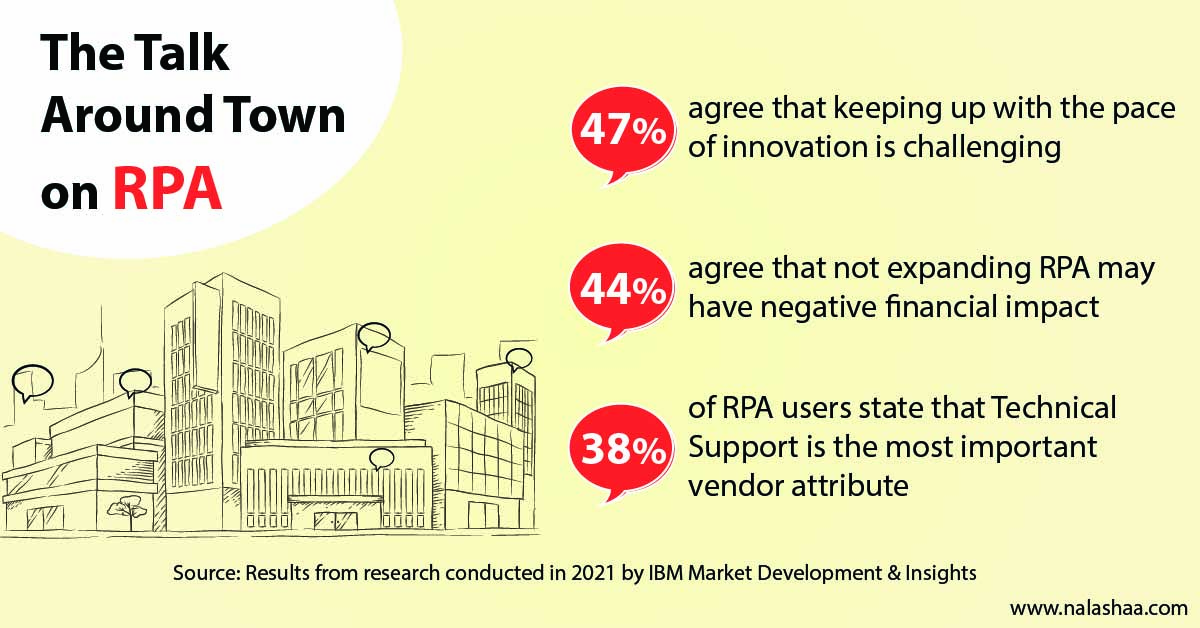
Look for These Services when you Buy an RPA Support Package
In a research carried out by IBM in 2021, among the top attributes that enterprises looked for when selecting RPA providers were - technical support, integration support, and globally deployment support. A staggering 30% of RPA users were ready to switch their vendors for a better support package.
This goes on to show that RPA support is a sought-after service in the market. However, before you invest in a support package, here’s what one should know. The essentials of an RPA support package are listed below to help enterprises make a well thought-through choice.
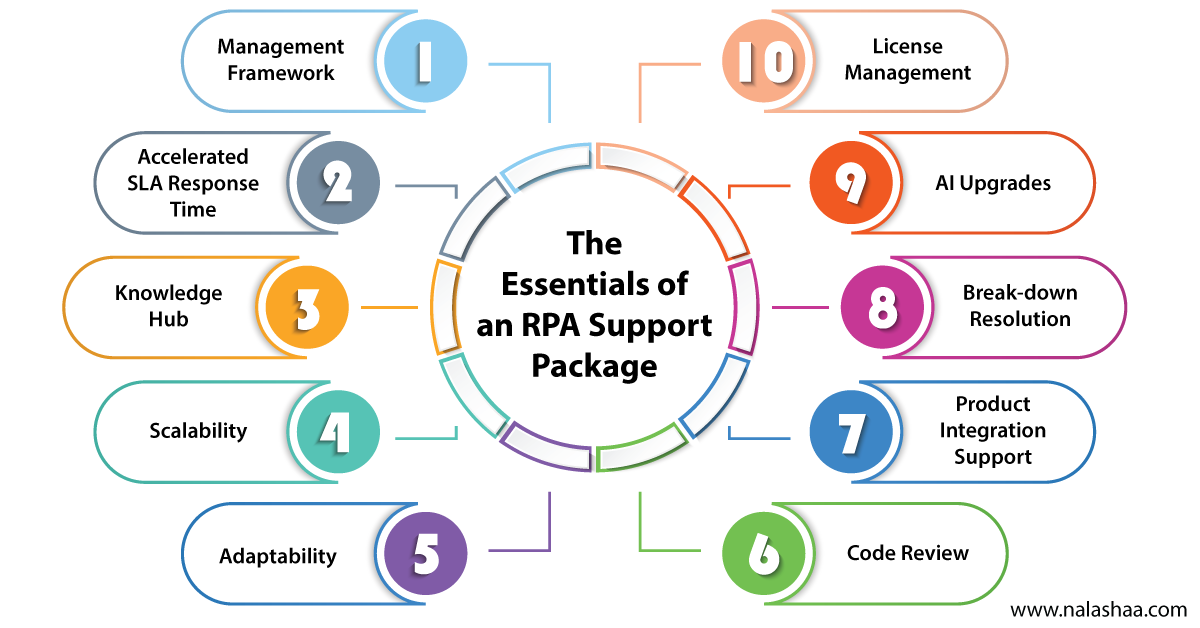
-
Establish Efficient Support with a Framework
Every project needs a project manager, and the same goes for RPA Support. Supporting an RPA is not just about maintenance and addressing support queries from the customer, it is also about scaling, code review, integration and so on as we shall discuss in the upcoming sections. However, managing these tasks without a documentation that outlines the process is like cordially inviting chaos into your organization.
The management framework a.k.a the process controller is an essential part of the support package, responsible for observing the bots in action. They shall also be used to raise alerts when the bot automation takes an ugly turn, or a feature development takes longer than scheduled. In short, the management framework ensures that the RPA support activities run in an efficient manner.
-
Accelerated SLA Response Time for Timely Error Mitigation
SLA response and resolution time is crucial to any project as it is to RPA support services. SLA response is the time gap between a customer raisese a ticket, and the time they receive a response to it. The response is on the lines of reassuring the customer that the organization is working on it. Automated responses sent out by bots, do not count in this case, it has to be a personal acknowledgment.
SLA resolution is when the ticket raised is resolved and the ticket is closed and this information is shared with the customer. With any decent support package, a detailed SLA response and resolutions time will be shared with the customer, prioritizing the ticket. Example, a downtime ticket will be resolved in 5 hours, a bug will take up to 24 hours, and a new feature request will be implemented between 48-72 hours.
Fractional FTEs and Dedicated Teams
The bright side of availing an RPA support package from a provider is that organizations are privy to round the clock support. With fractional FTEs sewn into contracts, enterprises have a dedicated team at a fraction of the cost of employing an in-house RPA support team.
An RPA support package without fractional FTEs is a farce and must be stepped away from.
-
Avoid Bot Hiccups with a Knowledge Repository
Implementing an RPA is the first step, learning to work with the RPA comes next. A regular RPA bot is not intelligent and thus does not learn in the course of time or take decisions based on learning. Which is why RPA bots need documentation or a repository from the provider’s side with regards to its working.
The repository will have detailed training materials on working with the RPA bot, on how to easily incorporate it into workflows and the best practices of the same.
Example: the knowledge hub/repository will include the best practices on bot re-usability, integration, raising tickets, scaling the bots, reviewing the bot periodically for any functionality breakdowns, etc.
-
Flexibility to Scale up/down bots as per work volume
First off, the process the RPA bot is currently working on must be scalable for the support package to implement scalability. RPA bots are usually recommended to be used on processes that can be scalable up or down, in the future.
Once regular RPA bots are implemented, they are not intelligent to scale up and down on demand by predicting the volume of work. In order to scale the bots, a dedicated support team needs to be present with a management framework on how to go about scaling the RPA bots.
-
Adapt to the New Market Requirements
As businesses evolve, so do the expectations of the market and the customer. In an attempt to adapt to the new requirements, businesses will consider it wise to automate more processes. This calls for building new functionality into the existing RPA bots, or introducing more bots into the workflows.
While adding new features to the bots, business rules pertaining to these functionalities may differ from the initial set. A support package that does not offer the services to implement new features/bots for adaptability, with the capability of introducing new business rules is a shakedown.
-
Absence of Code Review is a Recipe for Bot Deterioration
“Just because something works, doesn’t mean that it cannot be improved.” - wise words from the movie Black Panther. Leaning on to this, just because RPA bots work doesn’t mean it cannot be improved to perform better at an optimized rate. Which is why an RPA support package needs code review.
Allocated teams can go through the RPA bot’s code, and find opportunities for improvement. Owing to the code review, RPA bots will then execute the same process in less time, helping improve productivity. Here’s what must be done for a well-rounded code review:
- Verify the features of the RPA bot in line with the product requirement document.
- The code must be simple enough for the reviewers to understand its function without running it. If not, request the developers to improve the code readability.
- Maintain adherence to a code style guide while reviewing - which will eventually help the code readability.
- The functions and variables must be descriptive enough for a reviewer to realize what a class or module does, just by the function names and variables.
- Check for code duplication as newer members may create redundant libraries and functions, as they may not be aware of the existing ones.
- Carry out thorough testing of RPA bots where new features have been added, to reduce shadow deployments.
-
Create a holistic workflow with Integration Support
Product integration support is essential to an RPA support package. The need for an RPA bot is to traverse through multiple solutions/software to execute a process workflow, like a human does, but better. If the RPA is not able to integrate itself with the solutions/software necessary, then the whole point of having an RPA bot is redundant.
When looking for support packages, here are three things an enterprise must look for in a provider -
- The knowledge and expertise to connect the RPA to a myriad of end-points.
- The capability to establish new connections with ease.
- The ease of long-term maintenance of the new connections/integrations.
-
Regular bot Monitoring and Maintenance
To predict and avoid bots breaking amidst adding new features to the RPA bots, updating business logics, and trying to achieve expected results bots often deteriorate in efficiency or break. According to a study by Forrester of RPA Scalability, “45% of firms deal with bot breakage on a weekly basis or more often, and in the meantime, customer experience is impacted.”
This goes on to show that an RPA bot breaking down an expected phenomenon when implementing RPA. Therefore, resolutions to bot break-down must be part of any RPA support package.
-
Infuse Intelligence with AI Upgrades
As mentioned previously, regular RPA bots are not intelligent. RPA bots are built to only carry out repetitive human tasks. However, as part of evolving the process, it is quite common for organizations to want to implement AI into their workflows.
With RPA bots riddled with artificial intelligence, they are trained to recognize patterns and take action accordingly. With pattern recognition comes predicting requirements, taking intelligent decisions based on past data, proactive maintenance, scaling up and down, etc.
During festival seasons, when e-commerce websites are full of offers and discounts, there is bound to be a barrage of customer queries and complaints. There is no way customer support executives can handle that kind of volume. Thanks to intelligent RPA, bots can chat with customers and even address their queries and complaints. Since the bots are intelligent, they can also manage resources when it comes to scaling the customer support bots, in times like such. IT can also scale back down to match the decline in volume after the festival season.
So make sure that AI upgrades are included in your RPA Support Package.
-
Don’t Drop the Ball on License Management
A license, in short, is access to a platform/studio where organizations can customize a specified number of RPA bots. Purchasing an RPA license means different things depending on the vendor. The components or features granted to an organization within a platform/studio/robot as part of a license differ from one to another.
For example, let us look at licensing models from UiPath – a global organization that makes RPA software.
UiPath offers a platform that can build, manage, run, and deliver end-to-end RPA solutions. Within this are different components that help execute the above functions. The licenses granted by UiPath are specific to the components within the platform.
Licenses for Attended bots and Studio
Attended bots are those that can be used to accelerate front office tasks, best suited for sales, help desk, and call center activities. These are used within workflows that need human intervention.
A Studio within UiPath is where developers can build end-to-end automation workflows which will be executed by the bots, once they are deployed.
- The Named User license is one which grants access to one specific person to access the platform at any time through any machine.
- The Concurrent User license allows multiple people (previously specified number) to access the platform at the same time.
There are specific licenses for specific components, within every RPA platform offered by a vendor. Navigating through these licenses, their requirements, and then managing them should be taken care of by the RPA Support Service Provider. So, make sure there is a checkmark on the License management for the RPA Bots.
Quick and Smooth RPA Support Package Delivery
Needless to say, we’ve got you covered when it comes to supporting your RPA. With an experienced RPA partner like Nalashaa on your side, you can prioritize services that need attention while we customize, enhance, and monitor RPA.
Connect with our RPA experts at info@nalashaa.com and get your RPA the support it deserves.

Shireen Noushad
Forever curious to know how things work, be it technology or assembling a taco. As an ardent aesthete, I'm always writing, reading, or scrolling. At other times, I'm thinking about writing, reading, or scrolling.

